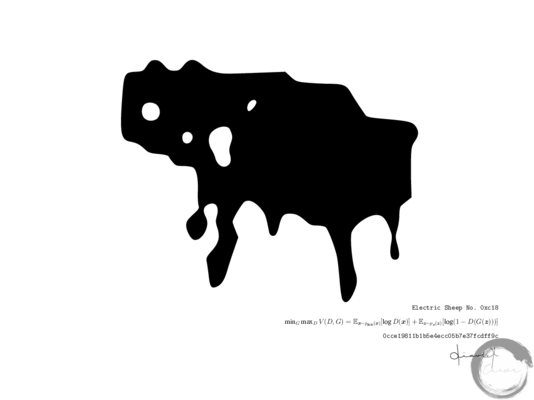A Short Overview on AI Art
A brief introduction to Artificial Intelligence Art (AI Art)

by Beth Jochim, Creative AI Lead at Libre AI
A Simple Definition
Artificial Intelligence Art (AI Art) is an artistic niche developed thanks to the latest advances in computer vision and deep learning. In particular, its development has been aided by the massive adoption by researchers and artists of Generative Adversarial Networks (GANs), a class of machine learning invented by researcher Ian Goodfellow and colleagues in 2014.
AI Art refers to any work of art created with the assistance of a system based on artificial intelligence and falls under the umbrella of Generative Art. The latter indicates art that has been created, in whole or in part, with the use of a (usually) non-human system capable of autonomously determining the characteristics of an artwork without the direct intervention of the artist.

A Few Important Milestones
Since the development of AI Art is largely based on the advances in deep learning, a family of methodologies within machine learning (which is part of artificial intelligence), we have also included some important dates concerning the field of AI. Moreover, as the artistic niche falls under the umbrella of Generative Art, which refers not only, but also to Algorithmic Art, we have included a few information related to Computer and Generative Art. Two resources were used to reconstruct a chronological order that took into account the sphere of both AI and art: the article of Gil Press "A Very Short History Of Artificial Intelligence" (1) appeared on Forbes, and the "Timeline of AI Art" by AIArtists.org (2).
1950: Crypt analyst and computer scientist Alan Turing introduced the “Imitation Game”, currently known as the “Turing Test”. The test measures the capability of a machine to show intelligence equal or identical to that of humans
1956: American computer scientist John McCarthy created the term artificial intelligence. He is considered one of the founding fathers of AI, together with Marvin Minsky, Allen Newell, Alan Turing, and Herbert A. Simon. With Minsky the field of AI started to follow a symbolic description approach also known as a top-down approach (3)
1959: Arthur Samuel, an American pioneer in computer gaming and AI, made popular the term machine learning, a sub-field of artificial intelligence that revolves around algorithms, which improve by the utilization of data and experience
'60 - '70: Computer Art pioneers such as Vera Molnár, Lillian Schwartz, Georg Nees, Frieder Nake, etc. explored the creation of art through generative systems (5)
'70 - '90: Academic and artist Harold Cohen designed AARON, a computer program able to autonomously create original images. The program has progressively developed since the beginning of the seventies and also investigates aspects related to creativity
1990: Roboticist Rodney Brooks pushed the idea of a bottom-up approach to AI. Inspired by the latest discoveries in the field of neuroscience, he brought the discourse on neural networks back to the fore (i.e., connections approach) (3)
1996: IBM supercomputer Deep Blue defeated chess grand master and world champion Garry Kasparov
2001: Computational Creativity Professor Simon Colton set up The Painting Fool webpage and declared the aim of the project: "to engineer a software system that is one day taken seriously as a creative artist in its own right". The Painting Fool is an AI-based system that paints original works “to address philosophical notions such as emotion and intentionality in non-human intelligences" while showing “behaviours that might be deemed as skillful, appreciative and imaginative.” The professor started working on the code as early as 1998 (4)
2001: Artist Casey Reas and data visualization expert Ben Fry designed Processing (5), an integrated development environment (IDE) thought for new media art, visual design, and electronic arts, which teaches non-tech savvy users the basics of computer programming using a visual context. Its impact on democratizing access to generative art has been huge
2009: In order to help the advancement of computer vision and the research in deep learning, Stanford researcher Dr. Fei Fei Li started the research project ImageNet. This is a large dataset of images made free to use for researchers. It maps the “entire world of objects”and is organized according to the WordNet hierarchy. It contains more than 14 million hand-annotated images labelled through crowdsourcing
2011: IBM Watson, a question-answering (QA) computer system based on natural language, won American quiz Jeopardy!
2014: Machine learning researcher Ian Goodfellow and colleagues designed a group of frameworks called Generative Adversarial Networks (GANs). GANs are made of two networks (i.e., Generator and Discriminator) that compete in a game to generate new images and have been popular since 2018
2015: Google engineer Alexander Mordvintsev created DeepDream, a computer vision program based on a Convolutional Neural Network (CNNs) that detects and enhances patterns in images. The output of the program has a hallucinogenic aspect and received great interest both from the scientific and the artistic community
2015: Neural Style Transfer (NST) was launched as a class of software algorithms that manipulate videos and digital images by taking a style or appearance of another image. In NST, deep neural networks (DNN) are used for transforming an image into something different based on existing styles
2016: Google DeepMind released AlphaGo, a computer program that made history defeating Lee Sedol, Go champion
2018: One of the first AI-based artwork was sold in Paris at the Grand Palais by researcher and artist Alagraphy (6)
2018: Edmond de Belamy, a work by French collective Obvious, was sold by Christie’s at auction for $432,500, bringing attention to the niche of AI Art
2019: Sotheby’s put at auction Memories of Passerby I, an AI-based artwork of pioneer artist Mario Klingemann. The lot sold at auction for £40,000
2020: OpenAI released GPT-3 (Generative Pre-trained Transformer 3) (7). Based on deep learning, it is a language model that produces human-like text. At the moment, it is one of the most powerful tool to generate natural language
2021: OpenAI released DALL-E (8), which is a program that creates images from descriptions based on text (i.e., "it is a 12-billion parameter version of GPT-3 trained to generate images from text descriptions"). It interprets inputs based on natural language and generates images that correspond to it utilizing a dataset of text–image pairs. "The images that DALL-E generates are curated by CLIP, which presents the highest-quality images for any given prompt"
2021: OpenAI released CLIP (Contrastive Language-Image Pre-Training) (9), a neural network that "learns visual concepts from natural language supervision"
References and Resources
(1) Press, Gil (2016), A Very Short History Of Artificial Intelligence (AI). https://www.forbes.com/sites/gilpress/2016/12/30/a-very-short-history-of-artificial-intelligence-ai/?sh=4b749fe86fba (Retrieved May 2021)
(2) AIArtist.org, Timeline of AI Art. https://aiartists.org/ai-timeline-art (Retrieved May 2021)
(3) Britannica Encyclopedia, Methods and goals in AI: Symbolic vs. connectionist approaches. https://www.britannica.com/technology/artificial-intelligence/Methods-and-goals-in-AI#ref739247 (Retrieved May 2021)
(4) Colton, Simon (2001), The Painting Fool. http://www.thepaintingfool.com/ (Retrieved May 2021)
(5) Bailey, Jason (2018), Why Love Generative Art? https://www.artnome.com/news/2018/8/8/why-love-generative-art (Retrieved May 2021)
(6) Wikipedia, Artificial Intelligence Art. https://en.wikipedia.org/wiki/Artificial_intelligence_art (Retrieved May 2021)
(7) Wikipedia, GPT-3. https://en.wikipedia.org/wiki/GPT-3 (Retrieved May 2021)
(8) OpenAI (2021), DALL·E: Creating Images from Text. https://openai.com/blog/dall-e/ (Retrieved May 2021)
(9) OpenAI (2021), CLIP: Connecting Text and Images. https://openai.com/blog/clip/ (Retrieved May 2021)
Photo (Cover) by Sharon Pittaway on Unsplash
